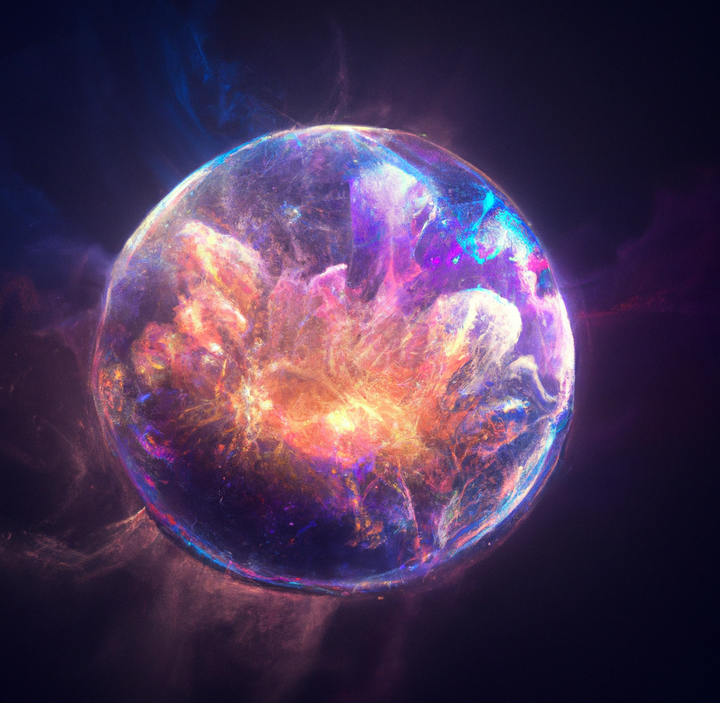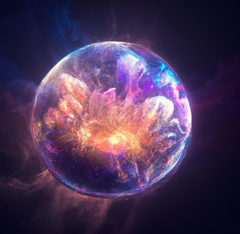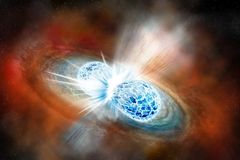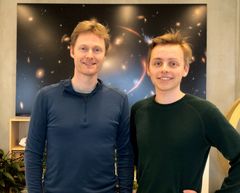Astrophysicists discover the perfect explosion in space

Kilonovae - the giant explosions that occur when two neutron stars orbit each other and finally collide - are responsible for creatingboth great and small things in the universe, from black holes to the atoms in the gold ring on your finger and the iodine in our bodies. They give rise to the most extreme physical conditions in the Universe, and it is under theseextreme conditions that the Universecreates the heaviest elements of the periodic table, such as gold, platinum and uranium.
But there is still a great deal we do not know about this violent phenomenon. When a kilonova was detected at 140 million light-years away in 2017, it was the first time scientists could gather detailed data. Scientists around the world are still interpreting the data from this colossal explosion, including Albert Sneppen and Darach Watson from the University of Copenhagen, who made a surprising discovery.
"You have two super-compact stars that orbit each other 100 times a second before collapsing. Our intuition, and all previous models, say that the explosion cloud created by the collision must have a flattened and rather asymmetrical shape," says Albert Sneppen, PhD student at the Niels Bohr Institute and first author of the study published in the journal Nature.
This is why he and his research colleagues are surprised to find that this is not the case at all for the kilonova from 2017. It is completely symmetrical and has a shape close to a perfect sphere.
"No one expected the explosion to look like this. It makes no sense that it is spherical, like a ball. But our calculations clearly show that it is. This probably means that the theories and simulations of kilonovae that we have been considering over the past 25 years lack important physics," says Darach Watson, associate professor at the Niels Bohr Institute and second author on the study.
The spherical shapeis a mystery
But how the kilonova can be spherical is areal mystery. According to the researchers, there must be unexpected physics at play:
"The most likely way to make the explosion spherical is if a huge amount of energy blows out from the center of the explosion and smooths out a shapethat would otherwise be asymmetrical. So the spherical shape tells us that there is probably alot of energy in the core of the collision, which was unforeseen," says Albert Sneppen.
When the neutron stars collide, they are united, briefly as a single hypermassive neutron star, which then collapses to a black hole. The researchers speculate whether it is in this collapse that a large part of the secret is hidden:
"Perhaps a kind of 'magnetic bomb' is created at the moment when the energy from the hypermassive neutron star's enormous magnetic field is released when the star collapses into a black hole. The release of magnetic energy could cause the matter in the explosion to be distributed more spherically. In that case, the birth of the black hole may bevery energetic," says Darach Watson.
However, this theory does not explain another aspect of the researchers' discovery. According to the previous models, while all elements produced are heavier than iron, the extremely heavy elements, such as gold or uranium, should be created in different places in the kilonova than the lighter elements such as strontium or krypton, and they should be expelled in different directions. The researchers, on the other hand, detect only the lighter elements, and they are distributed evenly in space.
They therefore believe that the enigmatic elementary particles, neutrinos, about which much is still unknown, also play a key role in the phenomenon.
"An alternative idea is that in the milliseconds that the hypermassive neutron star lives, it emits very powerfully, possibly including a huge number of neutrinos. Neutrinos can cause neutrons to convertinto protons and electrons, and thus create more lighter elements overall. This idea also has shortcomings, but we believe that neutrinos play an even more important role than we thought," says Albert Sneppen.
A New Cosmic Ruler
The shape of the explosion is also interesting for an entirely different reason:
"Among astrophysicists there is a great deal of discussion about how fast the Universe is expanding. The speed tells us, among other things, how old the Universe is. And the two methods that exist to measure it disagree by about a billion years. Here we may have a third method that can complement and be tested against the other measurements," says Albert Sneppen.
The so-called "cosmic distance ladder" is the method used today to measure how fast the Universe is growing. This is done simply by calculating the distance between different objects in the universe, which act as rungs on the ladder.
"If they are bright and mostly spherical, and if we know how far away they are, we can use kilonovae as a new way to measure the distance independently – a new kind of cosmic ruler," says Darach Watson and continues:
"Knowing what the shape is, is crucial here, because if you have an object that is not spherical, it emits differently, depending on your sight angle. A sphericalexplosion provide much greater precision in the measurement.”
He emphasizes that this requires data from more kilonovae. They expect that the LIGO observatories will detect many more kilonovae in the coming years.
FACT BOX: ABOUT KILONOVAE
- Neutron stars are extremely compact stars that consist mainly of neutrons. They are typically only about 20 kilometers across, but can weigh one and a half to two times as much as the Sun. A teaspoon of neutron star matter would weigh about as much as Mount Everest.
- When two neutron stars collide, the phenomenon of a kilonova occurs. This is the name of the gigantic explosion that the merger creates. It is a radioactive fireball that expands at enormous speed and consists mostly of heavy elements formed in the merger and its aftermath — both the lighter and the very heavy elements— which are ejected into space.
- The phenomenon was predicted in 1974 and first clearly observed and identified in 2013. In 2017, detailed data from a kilonova was obtained for the first time, when the detectors LIGO (in the USA) and Virgo (in Europe) sensationally succeeded in measuring gravitational waves from the kilonova AT2017gfo, which was in a galaxy 140 million light years away.
FACT BOX: ABOUT THE STUDY
- The analyses have been carried out on data from the kilonova AT2017gfo from 2017. The researchers have analyzed data from the kilonova. Those data are the ultraviolet, optical, and infrared light from the X-shooter spectrograph on the Very Large Telescope at the European Southern Observatory, combined with previous analyses of gravitational waves, radio waves and data from the Hubble Space Telescope.
- The scientific article about the study has been published in the journal Nature.
- The study is an important early result of the HEAVYMETAL collaboration, which was recently awarded an ERC Synergy grant.
- The following researchers contributed to the work: Albert Sneppen and Darach Watson from the Cosmic Dawn Center/ Niels Bohr Institute, University of Copenhagen; Andreas Bauswein and Oliver Just, GSI Helmholtzzentrum für Schwerionenforschung, Germany; Rubina Kotak from the University of Turku, Finland; Ehud Nakar and Dovi Poznanski from TelAviv University, Israel; and Stuart Sim from Queen's University Belfast, UK.
Nøgleord
Kontakter
Darach Watson
Associate Professor
Cosmic Dawn Center (DAWN)
Niels Bohr Institute
University of Copenhagen
+45 24 80 38 25
darach@nbi.ku.dk
Albert Sneppen
PhD-studerende
Cosmic Dawn Center (DAWN)
Niels Bohr Institute
University of Copenhagen
+45 28 97 64 34
albert.sneppen@nbi.ku.dk
Maria Hornbek
Journalist
Faculty of Science
University of Copenhagen
+45 22 95 42 83
maho@science.ku.dk
Billeder
Information om Københavns Universitet - Det Natur- og Biovidenskabelige Fakultet
 Københavns Universitet - Det Natur- og Biovidenskabelige Fakultet
Københavns Universitet - Det Natur- og Biovidenskabelige FakultetBülowsvej 17
1870 Frederiksberg C
35 33 28 28https://science.ku.dk/
Det Natur- og Biovidenskabelige Fakultet på Københavns Universitet – SCIENCE – er landets største naturvidenskabelige forsknings- og uddannelsesinstitution.
Fakultetets væsentligste opgave er at bidrage til løsning af de store udfordringer, som vi står overfor i en verden under hastig forandring med øget pres på bl.a. naturressourcer og markante klimaforandringer - både nationalt og globalt.
Følg pressemeddelelser fra Københavns Universitet - Det Natur- og Biovidenskabelige Fakultet
Skriv dig op her, og modtag pressemeddelelser på e-mail. Indtast din e-mail, klik på abonner, og følg instruktionerne i den udsendte e-mail.
Flere pressemeddelelser fra Københavns Universitet - Det Natur- og Biovidenskabelige Fakultet
Nyt studie peger på Skagerrak som et slags ”fritidshjem” for den gådefulde grønlandshaj9.7.2025 09:00:00 CEST | Pressemeddelelse
Grønlandshajen – verdens længstlevende hvirveldyr – forbindes oftest med kolde arktiske vande. Et nyt internationalt studie ledt af forskere fra Grønlands Naturinstitut og Københavns Universitet viser dog, at Skagerrak sandsynligvis fungerer som opvækstområde for unge grønlandshajer. Studiet peger også på at grønlandshajer slet ikke fødes i hverken Grønland eller andre steder i Arktis.
Old aerial photos give scientists a new tool to predict sea level rise3.7.2025 08:00:00 CEST | Press release
Researchers from the University of Copenhagen have gained unique insight into the mechanisms behind the collapse of Antarctic ice shelves, which are crucial for sea level rise in the Northern Hemisphere. The discovery of old aerial photos has provided an unparalleled dataset that can improve predictions of sea level rise and how we should prioritise coastal protection and other forms of climate adaptation.
Gamle luftfotos giver forskere nyt redskab til at forudsige havstigninger3.7.2025 08:00:00 CEST | Pressemeddelelse
Forskere fra Københavns Universitet har fået unik adgang til at forstå mekanismerne bag antarktiske ishylders kollaps, som er afgørende for havstigninger på den nordlige halvkugle. Et fund af gamle luftfotos har skabt et enestående datasæt, som kan forbedre vores forudsigelser af hvor meget havene stiger, og vores prioritering af kystsikring og andre klimatilpasninger.
Ny institutleder på IFRO: ”Faglighed og fællesskab går hånd i hånd”1.7.2025 10:49:17 CEST | Pressemeddelelse
Per Svejstrup er fra 1. august ansat som institutleder på Institut for Fødevare- og Ressourceøkonomi (IFRO). Den kommende leder træder ind i rollen med stor respekt for IFRO's faglige og kollegiale kultur med klare ambitioner for fremtiden.
Dangerous Variant of Salmonella Still Not Eradicated – Researchers Point to the Solutions1.7.2025 09:53:23 CEST | Press release
The infectious and multi-resistant cattle disease Salmonella Dublin can be fatal to both humans and animals and causes significant losses for farmers. Although Denmark has attempted to eradicate the disease since 2008, it has not yet succeeded. A study from the University of Copenhagen points to possible reasons – and the necessary solutions.
I vores nyhedsrum kan du læse alle vores pressemeddelelser, tilgå materiale i form af billeder og dokumenter samt finde vores kontaktoplysninger.
Besøg vores nyhedsrum


